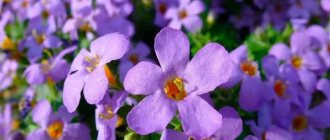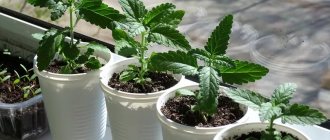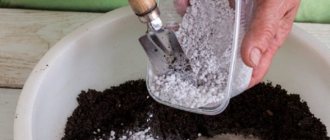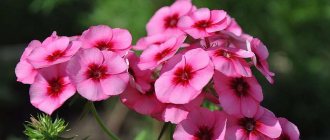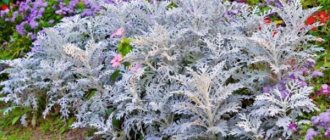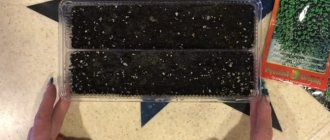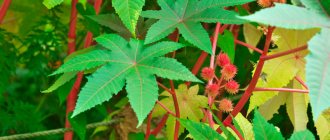Many gardeners like to plan their front garden or flower bed, that is, a combination of colors and sizes of flowers. Some experienced flower gardeners have concluded that carnations are perfect for any flower bed; they are a decoration for any flower arrangement.
But many questions arise about when to sow cloves for seedlings, when to plant them in open ground and how to care for them. You will find the answer to all these questions below, and so that you can definitely grow carnations, we share some tips and tricks.
Perennial carnation (lat. Dianthus) is widespread throughout the world. The botanical name of the herbaceous plant means divine flower
When to sow cloves for seedlings, in what month
If you really like carnations and want to plant them in your garden or vegetable garden, then most likely you are wondering when to sow cloves?
The best time to sow carnations is the end of January or the first days of February; some flower beds sow them in early March, but you don’t need to do this too late. The plant needs quite a long time to develop normally.
You also need to take into account the climatic characteristics of your region, for example, the optimal time for sowing in Moscow is mid-February, and in the southern regions the last days of January are suitable.
You can navigate according to the lunar calendar, this is very convenient, because you can immediately determine both favorable and unlucky days
Days on which it is best to sow seedlings:
- January – 27-29;
- February – 1-8, 10-20, 25-28;
- March – 2-14, 29-31;
- April – 1, 2, 5, 6, 7, 9, 18-20, 24, 25.
Days on which it is strictly forbidden to work in the garden:
- January – 10, 25,26;
- February – 9, 21, 22, 23;
- March – 9, 19, 20, 21,24;
- April – 8, 15,16, 17,23.
Varieties and varieties of Turkish cloves
Breeders have developed many hybrids of Turkish cloves. Only a few of their species are grown in our latitudes.
All hybrid carnations are divided into three large categories, which depend on the size of the bush:
- tall (55-60 cm);
- short (25 cm or less);
- medium height (25-45 cm)
It is not possible to divide carnations by type of bud color, since there is such a variety of color palettes that it does not fit into any classification. Red, burgundy, cherry flowers look especially impressive in combination with white, fawn or pink buds. Varieties with an “eye” (those flowers in which the central part of the bud is colored in a shade contrasting with the outer part of the flower) do not give up their positions. Popular varieties of the plant are described below.
Holborn Glory
One of the most popular tall varieties. It has been grown for more than a century and does not lose its relevance. The bushes grow up to 55-65 cm in height and have a strong, erect shape. The leaf blades and stems have a bright green tint. The flowers are formed in a round shape (the diameter of each is 1.5-2 cm) and are collected in inflorescences up to 11 cm in diameter. The petals have a burgundy fringe with white splashes and a center. This variety loves partial shade, does not require special care, and blooms from June to early August.
Newport Salmon Pink
Belongs to the category of medium-growing varieties. The bushes usually grow to 45-55 cm. Each bush has elastic, strong stems that are covered with long lanceolate leaves of a rich green hue. The flowers of this variety are small, salmon-pink in color with a jagged edge. It begins to bloom at the end of May and continues throughout the month.
Nigricans
A dark, erect variety, with rigid stems 45-55 cm high. It is characterized by burgundy veins on the stems and leaves. The inflorescences of this variety are quite large (up to 10 cm), having crimson velvet flowers with a white petal base. Flowering period: June - early August.
Diabunda F1
A hybrid of Turkish and Chinese carnations, available in many color variations. It is distinguished by its compact bush size (20-25 cm) and long flowering. It has rather large flowers (diameter of each 2.3-2.6 cm) with satin petals and a jagged edge.
Variety selection
Nature has created about 300 types of carnations, but only about 10 are available for cultivation. The most common varieties of carnations are:
Turkish
This variety of carnation is a miniature bush on which many small inflorescences bloom.
The peculiarity of this variety is that inflorescences of completely different colors can be combined on one bush, from white to dark burgundy.
Growing Turkish carnation is absolutely no problem even for a novice gardener; it is easy to care for and grows quite quickly.
Cirrus
This variety of carnation came to us from the Alps, it looks quite unusual, and all because of its leaves with deep cuts. From a distance it may seem that these are not flowers, but terry balls.
Pinnate carnation is perfect for decorating paths or flower bed edges.
Chinese
The bluish tint is what makes this variety distinctive, the inflorescences come in different shapes, and the color usually ranges from white to dark red or burgundy.
The most common form of this variety is bicolor; many flower gardeners are confident that these are the carnations that can decorate absolutely any flower bed.
Chinese carnation
Dutch
This is a perennial variety of carnation, but this is not its only feature; it also blooms continuously, from the second half of June until the first frost.
Its color can come in a variety of shades, but the most common is red with a white border along the edge of the petals.
Dutch carnation
Possible problems and their solutions
Despite the fact that the crop is considered perennial, it often has to be cultivated again in the 3rd year. To preserve the plant, you can use the cutting method. Select the most successful shoots and dig them into the area. Provide care and abundant watering for rooting.
The enemies of the Turkish carnation are pests such as aphids, spider mites and mole crickets. Having noticed insects, hurry to neutralize them using insecticides or traditional methods. An infusion of potato tops will do. For this:
- About 1 kg of tops is infused in 1 bucket of water.
- After keeping the composition for 1.5 days, the liquid is drained.
- Add 1 tablespoon of liquid soap.
- Spray the clove bushes with the mixture.
The crop is susceptible to diseases such as fusarium and rust. They arise due to excess moisture and overfeeding with nitrogenous fertilizers. Following the rules of care will help eliminate such problems.
If the disease occurs, severely damaged bushes must be removed and the soil treated with a septic tank. If the lesions are weak, the plants should be sprayed with HOM or other analogues.
The unpretentious culture is easy to care for. By following simple rules, even an inexperienced gardener will be able to provide conditions for the harmonious growth and development of Turkish carnations. Correct calculation of the timing of sowing and planting in an open area will help to obtain strong and healthy plants with bright varietal characteristics.
Features of cultivation
The peculiarity of growing cloves is that it does not require several stages of picking. Doing this at home is much easier than in the open ground.
Carnations are planted early, and not every region can boast of warm winters, so an additional source of heat and light will be required.
Selection of capacity
There are no strict requirements for the capacity, the main thing is that it is large, but not very deep. A regular plastic container or cardboard box works well.
After picking, the sprouts will need to be transplanted into separate pots or peat tablets, in which case they may be smaller but deeper.
Seed selection and preparation
When you come to the store to buy seeds, carefully inspect the packaging; there should be no damage to it. They may indicate that the seeds were transported or stored incorrectly, this leads to damage to the planting material, and bad material will not produce beautiful flowers.
Before planting, he recommends disinfecting the seeds; to do this, it will be enough to soak them in a solution of potassium permanganate for 15-20 minutes. Disinfection can avoid any diseases.
Disinfection of seeds before sowing
You can also treat the seeds with immunomodulators, they strengthen the plant’s immunity.
When purchasing a package of seeds, check for recommendations on the back; there should also be information about the manufacturer.
Soil preparation
Soil for carnations can be bought in the store; universal soil for flower crops is suitable for it. But you can do it yourself, for this you will need:
- River sand, it must be washed;
- Turf land;
- Peat;
- Humus.
Make sure that the soil is light and loose; it should allow moisture and air to pass through well.
After preparing the soil, it must be disinfected; to do this, it must be steamed for one hour.
Direct sowing
In order to create optimal conditions for carnation germination, you need to follow the following steps:
- If your container does not have drainage holes, then you need to create them, this will prevent water stagnation;
- Next, we create a drainage layer, but it should not be thicker than 2 cm;
- Fill the container with soil, but not to the very brim;
- Don't forget to moisten the soil with a spray bottle;
- After the liquid is completely absorbed, make small indentations;
- Plant seeds in the holes and cover with a small layer of sand;
- Do not forget that after all the procedures you also need to water;
- Create a greenhouse effect in your mini-garden by covering the container with a bag or lid.
Water for irrigation at all stages of planting must be infused and clean; in no case should you use tap water
Preparing for sowing
The development and health of seedlings depends on the proper preparation of seeds, soil and containers for planting.
Seed preparation
One of the main factors in obtaining strong and viable seedlings is the use of fresh, healthy, pre-treated seeds as planting material. Particular attention must be paid to the preparation of seed collected from one’s own plot.
Self-collected seeds very rarely completely repeat the varietal characteristics of the parent plants.
The first step in selecting high-quality seed is an external examination, during which damaged and smallest seeds are rejected. If you have a lot of seeds or they are quite old (collected more than 2 years ago), you can calibrate them using a saline or sugar solution:
- 2 tsp. (salt or sugar) dissolve in 1 glass of water.
- Dip the seeds into the resulting solution.
- Pop-up instances are deleted.
- The remaining seeds are washed and dried.
This method allows you to select the best specimens from a large number of seeds. But you should not use it with a small amount of planting material, since among the floated specimens there may be quite viable ones.
Selected seeds must be subjected to:
- disinfect for 2 hours in a slightly pink solution of potassium permanganate, or use fungicides in accordance with the instructions (Fitosporin, Fundazol, Baktofit, Vitaros);
- treatment with growth stimulants (Energen, Zircon, Epin-extra), following the recommended dosages.
When planting purchased seeds, important information about the need for pre-sowing treatment is indicated on the packaging.
Soil selection
To plant Turkish cloves for seedlings, you should choose fertile, neutral or slightly acidic, water- and breathable soils. You can use universal soil purchased at a garden store. If the flower mixture does not contain leavening substances (vermiculite, perlite, sand), you need to add them yourself: for 4 parts of soil - 1 part of baking powder.
It’s easy to prepare your own soil mixture for sowing. To do this you need to mix:
- garden soil - 2 parts;
- humus – 1 part;
- peat – 1 part;
- sand – 0.5 parts.
Or
- peat – 2 parts;
- turf soil - 2 parts;
- sand - 1 part.
You can not use soil, but sow in peat tablets, this will help avoid picking, which Turkish cloves do not really like.
Soil mixture prepared independently requires mandatory disinfection. It is carried out 1-3 days before planting with one of the drugs: Fitosporin-M, Glyokladin, Gamair, Trichocin, Alirin-B, using in strict accordance with the instructions.
The soil can also be calcined in the oven for 1 hour at a temperature of 70°C. Potassium permanganate (a slightly pink solution is prepared) or hydrogen peroxide (1 tablespoon diluted in 1 liter of water) are also suitable for disinfection, sold in any pharmacy. The prepared solution is poured onto the soil prepared for seedlings.
Selection of capacity
The preferred option for sowing Turkish clove seeds is peat containers or tablets. You can also use plastic, paper or ceramic containers, both individual and common, 7-10 cm deep. Be sure to provide drainage holes in the planting containers.
All seed containers, except peat and paper ones, are disinfected. Ceramic containers washed with soap are scalded with boiling water or sterilized in the oven, plastic containers are treated with a rich pink solution of potassium permanganate.
Tips for caring for her
Carnations do not require careful care, but they need constant watering and light, both before and after germination. In order for you to grow a large and beautiful carnation, you need to follow several rules:
- After sowing, place the container in a room with a temperature of 18-20 degrees;
- Watering before emergence should be done from a sprayer; the cloves should be watered when the top layer of soil dries a little; the soil should not be allowed to be too wet;
- It is necessary to ventilate the mini-greenhouse; to do this, just remove the lid for 20 minutes once a day.
With proper care, the first shoots can appear within 4-5 days
Irrigation scheme
Watering before the emergence of shoots should be done from a sprayer and only as the top layer dries, and after the first shoots appear, watering should be done even more carefully.
In no case should you pour too much water in too large a stream; the plant is very susceptible to fungal diseases, and excess moisture can become a catalyst for the occurrence of these diseases.
Water should not be allowed to get on the stems and leaves; it is best to water the sprouts from a syringe
Top dressing
The carnation will delight you with its beauty if you take care of it in a timely manner; in addition to watering, you can sometimes feed the plant. At the initial stage of cultivation, nitrogen-containing fertilizers are suitable.
It is best to choose complex fertilizers that contain all the necessary substances.
Fertilizers must be applied strictly according to the instructions on the package; intentionally increasing the dose will only harm the plant.
Picks
Picking should be done only when you see that the plants have developed sufficiently and can withstand transplantation. The first pick should be no earlier than the first two green leaves appear, and the second – four leaves.
Before picking, you need to treat the soil and container, this is necessary in order to avoid any diseases
Carnation transplantation scheme:
- Before replanting, water the soil thoroughly;
- Prepare the container for transplantation: make drainage holes and lay a drainage layer, and fill the container with soil;
- Next, look how much the root has grown and make a hole slightly larger than the entire root system;
- Move the sprout to a new container and dig down to the cotyledon leaves.
After the procedure, you need to let the plants adapt a little, then they can be treated with a growth stimulator solution.
Other ways to propagate flowers
Propagation of Turkish carnation by cuttings
Planting of Turkish cloves is carried out with seeds and seedlings according to the above schemes, but the varieties you like can be propagated in other ways. You can propagate a flower plant using layering, for this:
- choose a suitable plant stem;
- they press him to the ground;
- pressed and fixed at the top with a bracket;
- before this, the peduncle must be removed;
- the stem is fixed with soil, which is pre-moistened;
- wait at least thirty days, periodically moistening the soil;
- Move the rooted shoots to the flowerbed, as they will receive all the features of the mother variety.
You can try to propagate the plant using cuttings that have already been growing for at least two years. These cuttings are transferred to a permanent place where increased soil looseness, abundant watering and slight shade are provided. It is necessary to monitor the general condition of the cutting daily, since after twenty-one days new leaves will appear on the rooted plant.
It is allowed to replant the cuttings only at the end of summer, but the plant will not bloom until next year. Experts advise propagating Turkish cloves by cuttings in a greenhouse or hotbed, this way you can root it much faster and save your favorite variety for the third year.
In Turkey, similar flowering plants grow in the fields; they are able to reproduce by seeds on their own. When self-seeding, the properties of carnations do not change, but the flowers may become smaller in size.
Pests and diseases
Carnation has a fairly strong immune system; it is difficult for diseases and pests to defeat it. The cause of disease can be infection; to prevent this, it is necessary to disinfect the soil, container and seeds.
Another common cause of disease is frequent watering.
Rust. With this disease, red spots appear; to cure the plant, you need to remove the affected leaves and treat the plant with a solution of Bordeaux mixture.
Mosaic disease. Black and white spots, which later cause holes to form. This disease cannot be treated; the plant just needs to be thrown out and the planting site treated.
Fusarium. This disease can be identified by a change in the color of the leaves from green to yellow, and blackening of the stem is also observed. This disease also cannot be treated; the plant simply needs to be disposed of.
Many plants can die due to attack by aphids, mites or any other insects; they can eat the above-ground part of the plant
Because of them, the carnation may lose its decorative effect; laundry soap helps fight pests; you can dilute a little soap with water and spray the plants with this solution.
Brief information about the plant
Turkish carnation is a beautiful unusual plant, on one stem of which there is a whole cap of five-petaled flowers, framed by a large number of narrow leaves. It is for these leaves that form a kind of “beard” that the flower received its second name - bearded carnation.
The flower is loved in many countries, but it is especially revered in England, where it is also called Sweet William. In this country, the bright petals of this flower are used in cooking. Many special occasions are not complete without the inclusion of Turkish carnations in bouquets and flower arrangements. Even at Prince William's wedding, Turkish carnations were part of his bride Kate Middleton's bouquet.
Transplantation into open ground
The average time for transplanting carnations into open ground is May; the plant has fairly good frost resistance, but it is better to replant it when the night frosts have completely passed.
Before transplanting, you need to choose a place in advance; it should be well lit and without drafts.
It is necessary to add complex fertilizers to the soil, remove weeds, dig and level.
Plants are transplanted into open ground according to the same scheme as picking. The only difference is that the distance between seedlings must be at least 25 cm.
Planting seedlings in open ground
As mentioned earlier, plants should be planted in open ground after the night frosts have passed.
Hardening before planting
Before transplanting a plant outside, it should be hardened off; to do this, you need to ventilate the room in which the plants are located. Then you need to take the container outside, at first an hour will be enough, every day increase the time the container stays outside.
Selecting a location
First of all, the place should be well lit and protected from the wind.
Also, make sure that the soil is sufficiently light and loose.
Site preparation rules:
- Dig up the area after putting complex fertilizer in it, you can use humus;
- If your site has too clayey soil, you can add river sand;
- If the soil is too acidic, add wood ash.
Direct drop off
Planting a plant in open ground is a very simple matter, the main thing is that the place is chosen correctly.
- Water the plant thoroughly before planting;
- Dig planting holes, a distance of at least 30 cm;
- Transplant the plant along with the soil into the hole;
- Compact the soil a little and water;
- Monitor soil moisture levels and remove weeds promptly.
Picking the Shabot carnation: terms, rules
When growing seedlings of this flower crop, 2 picks are required. The soil for picking can be used the same as for planting. However, when using soil made with your own hands at home, it is recommended to increase the proportion of humus. If you plan to dive into purchased soil, you should also add a little humus.
First pick
The first time to pluck carnation seedlings is when two true leaves appear . At this stage, you should choose individual cups with a diameter of about 5 centimeters (the optimal volume is 100 ml), but no less.
Scheme of the first picking of Shabot carnation seedlings:
- Two hours before the event, water the seedlings.
- Prepare the container in advance: make drainage holes in it, put a layer of drainage on the bottom, fill it with soil and water it.
- Using a plastic spoon or wooden stick, separate the seedling, being careful not to damage the roots or shake off the soil from the roots.
- Make a small indentation in the middle of the cup, for example, using your finger or pencil.
- Carefully transfer the seedling into the hole; the roots should not bend.
- Seedlings need to be buried down to the cotyledon leaves.
- Carefully cover with soil, compact the soil around very slightly and water.
Second pick
The optimal timing for the second pick of the Shabot carnation occurs when the plants are in the phase of 8 true leaves (that is, 4 pairs) . It is necessary to dive using the transshipment method, that is, the earthen lump is not destroyed. Now you should use individual cups with a diameter of about 10 centimeters and a cup volume of 500 ml.
Instructions for the second picking of seedlings:
- Water the plants 1-2 hours before the procedure.
- Prepare cups, put drainage on the bottom, fill with soil.
- Make a hole in the ground that matches the size of the seedling's earthen ball.
- Carefully remove the earthen lump from the cup without destroying it and transfer it to a new container. The depth level is up to the cotyledon leaves.
- Lightly compact the soil and water the plants in the new location.
Care after picking
Rules for caring for Shabot carnation seedlings after the first and second picking:
- Immediately after the procedure, for better rooting and adaptation, it is recommended to water the plants with a solution of a drug that stimulates root growth, for example, “Kornevin”.
- After two or four weeks, you can feed the seedlings with a complex mineral fertilizer containing potassium, phosphorus and nitrogen (Nitroammofoska is suitable), but the concentration of the fertilizer is reduced by half the dosage indicated in the instructions. You can also use specific seedling fertilizers.
- Plants need to be pinched at their growing points. The procedure is carried out when the seedlings have the 5th pair of true leaves (you need to pinch off in the place after the 3rd pair of leaves). Thanks to the manipulation, side shoots will begin to actively develop, the plant will have more flower stalks, and therefore the flowering will be more luxuriant.
Outdoor care
After transplanting the plant into open ground, it also needs care; there are several recommendations that will help you grow a beautiful carnation.
Top dressing
You can feed cloves using nitrogen fertilizers, but only after planting.
As soon as the first buds appear, switch to potassium-phosphorus fertilizers, but if the soil on your site is completely poor in nutrients, you can use mineral fertilizers.
Trimming flower stalks and pinching
It is necessary to remove and trim faded inflorescences in a timely manner, otherwise the carnation will lose its decorative effect and will no longer decorate your flowerbed.
If you are a fan of lush flowers, then you need to regularly pinch the stepsons, and you also need to remove the side buds.
Conditions for crops
Turkish clove seeds do not require light until they emerge, so the seedling containers can be placed in an unlit place and opaque materials (paper, cardboard, plastic) can be used as shelter. The optimal temperature for seed germination is +18-19°C.
An important point is the availability of air, so covered containers must be ventilated 2-3 times a day for 10-15 minutes. You can also make small holes in the lid, or leave gaps between the shelter and the edges of the seed containers for air access.
Maintaining a stable level of humidity is an indispensable condition for the emergence of seedlings. Do not allow the soil to dry out or become waterlogged. Watering during this period is carried out only with a fine sprayer.
Plant diseases
It is extremely rare for carnations to get sick; this usually happens during heavy rainfall, as the soil becomes too wet.
Alternaria blight can affect carnations, causing black or brown spots to appear on the leaves and stems.
Another popular disease is rust, the name speaks for itself; red spots appear on the back of the leaves.
If you notice any disease, immediately remove the plant and water the planting site with a disinfecting solution.
Carnation rust
In case of viral diseases, the plant begins to slowly die; the cause of such diseases can be pests or untreated garden tools. In order to prevent the spread of the disease, it is necessary to get rid of the diseased plant.
In order to prevent the appearance of any plants, it is necessary to disinfect the seed, soil and container for planting. Also, treat plants against pests and remove weeds in a timely manner.
Growing from seeds to seedlings
To grow cloves in this way, sowing seeds is required in March-early April. Take several containers for future seedlings, heat the soil (before putting it into the container), and pour in a non-concentrated solution of manganese. Add humus, peat or fine sand to the soil.
After the preparatory activities, you can start sowing:
- Fill the containers with prepared soil;
- Make shallow holes and pour seeds into them to a depth of 10 mm. Maintain a distance of 2 cm between each hole;
- Cover all containers with cling film and leave them in a warm room for 14 days. Do not forget to regularly moisten the soil;
- As soon as the first shoots appear, remove the film and move the containers to the windowsill;
- When stems with two leaves appear in the seedlings, they are picked and each shoot is transplanted into a peat pot or plastic cup;
- Before planting seedlings, they will need to be hardened off. To do this, every day for a week you need to take the sprouts outside during the daytime.
How to preserve cloves in winter
In order to enjoy the beauty of carnations next year, but without unnecessary problems, you can save the bushes in the winter and then make cuttings from them.
The strongest and healthiest bushes must be cut and placed in a pot along with a lump of earth. They should be stored in a cool place
How to cut carnations in spring? Cuttings of carnations in the spring should occur in the following stages:
- Cuttings are made from the part located in the middle; the cuts should be in the internodes; make sure that the cuts are oblique;
- The lower leaves are removed, and the cuttings are treated with a disinfecting solution;
- The cuttings are planted in boxes that must be filled with sand;
- Cover the cuttings with a clear plastic bag.
New leaves and roots will begin to appear in a few weeks, but do not forget to open the bag for a few minutes during the first two weeks, this procedure must be done every day.
How to plant seeds in a greenhouse?
Planting Turkish clove seeds in a greenhouse
In order to get viable carnation seedlings, you will have to choose the right place for it - more sun and a minimum of drafts. In order to grow a viable plant, it is necessary to maintain a temperature of thirteen degrees under the film.
Carnation sprouts will appear more quickly fourteen or twenty-one days after they hit the ground. After the plants have grown slightly, they are dug up and placed on other ridges, feeding them with nitrogen substances for rooting.
As soon as the air temperature rises above thirteen degrees Celsius, small carnations are transplanted to a permanent place of growth - a flower bed. Be sure to maintain a distance of twenty-five centimeters between flowers so that they have enough nutrients, light and moisture.
The advantage of carnation seedlings obtained in a greenhouse is that the growing season is extended, so you don’t have to cut off the pedicels and enjoy the lush flowering this year.
Description and photo
The plant looks like a small shrub. The stem is strong, the leaves are mostly narrow. After flowering, seed pods appear in the axils of the stems. The fruits are brown or brown in color. Depending on climatic conditions, the plant can bloom in one place for 2-3 seasons, after which it must be replanted. The rhizome of garden carnation is poorly developed and lies in the ground no deeper than 10–20 cm.
- The stem is thin, strong, the leaves are usually narrow, colored dull green or bluish-green.
- At the end of the flowering period, fruits appear on the stems - seed pods.
- The color of the seeds is brown or brown.
When does carnation bloom? The flowering period lasts from mid-June to the end of October.
All Dianthus are herbaceous plants. Depending on the climate and growing conditions, they can produce two types of shoots: with peduncles and vegetative ones. Carnations differ in color, number of buds and types of petals. Cultivated garden varieties are represented by a wide color palette - from soft pink to bright red or purple.
In outline
These are mostly low-growing plants:
- the root of an adult bush is not deep, only about 15-20 cm;
- the herbaceous part of the plant does not reach a height of more than 60-70cm;
- Two types of stems grow from one bush: flowering and non-flowering. The flowering stems are taller and others have more greenery.
- a large selection of colors: azure flowers, snow-white, different tones of scarlet and purple.
- persistent pleasant aroma and long-term preservation of freshness when cut, if you put the flowers in water.
Flower in landscape design
This flower looks organically in any part of the garden and can decorate any flower bed. Flower growers use this plant when creating an alpine slide, creating intricate and original patterns with the help of plants.
Turkish carnation flowers are deservedly considered a universal type of flower. They have a magnificent appearance, are easy to care for, and are unpretentious to growing conditions. With their help you can decorate even a small, modest area. Thanks to the abundance of colors, you can create a spectacular flower bed from carnations alone.
Rate the article, share the material with friends on social networks, and express your opinion in the discussion below!
